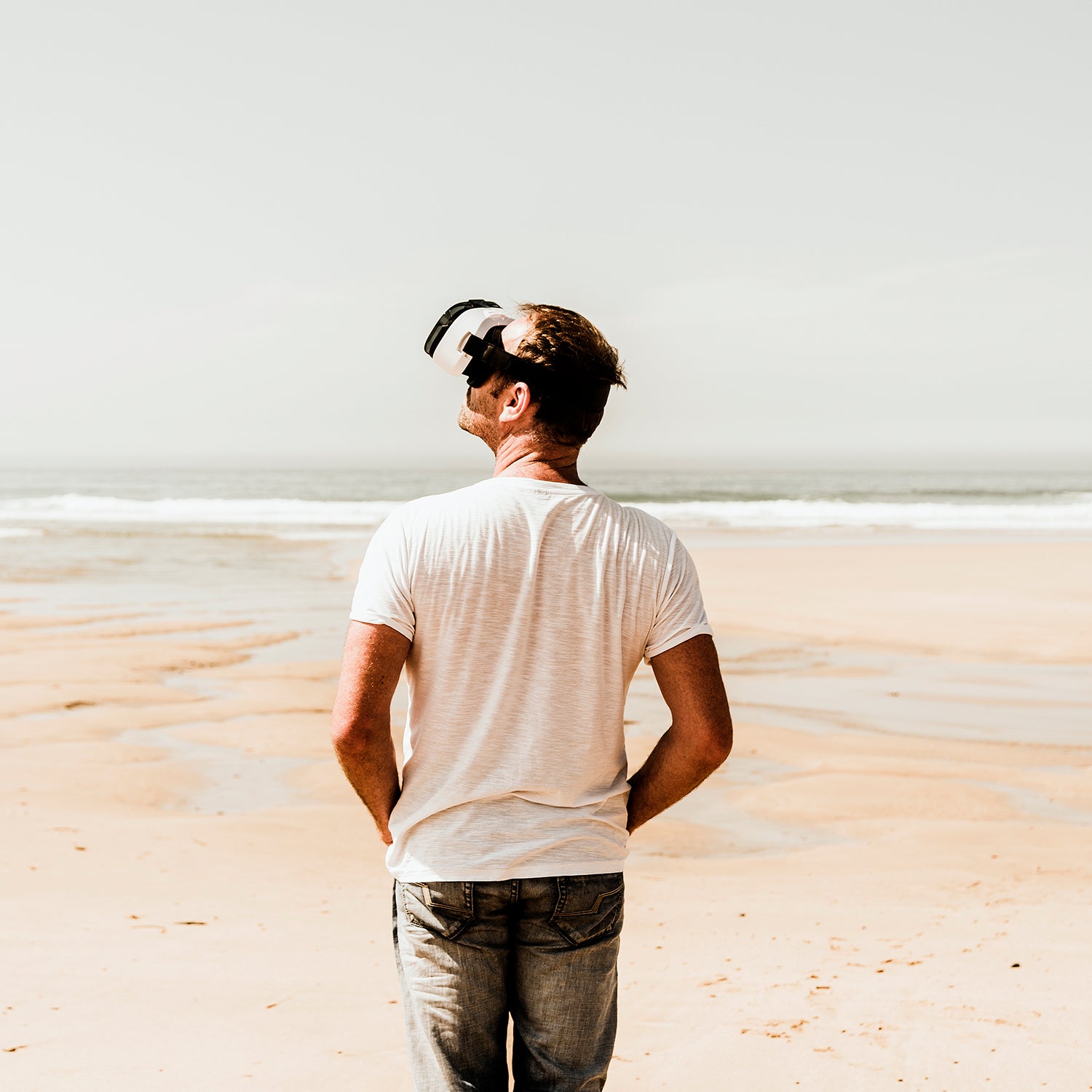Virtual reality, we were told, was going to transform outdoor sports. The technology’s promise was unbounded. Whitewater boaters would scout rapids virtually. Gear shoppers would skip the stores to crawl around inside virtual tents at home. Perhaps most promising of all, urbanites would get an alluring taste of the wilderness through immersive experiences in cinemas and arcades. Here was tech that would inspire more people to get outside.��
Turns out��all those expectations, built up over the past decade, were… virtual. In the outdoor community, VR has largely been a bust. And no, it’s not because the Gore-Tex crowd is dominated by Luddites. Quite the opposite is true. Today’s GPS-enabled campers and hikers carry personal-locator beacons, packable solar arrays, and fitness trackers, among other connected devices. Google Earth was long ago adopted for trip planning. With the exception of indoor cycling, VR has not become an important part of the adventurer’s technology quiver. And it won’t be anytime soon.��
This isn’t for a lack of trying. Back in 2015, the North Face produced a short VR film, Nepal, with beautiful footage of a Renan Ozturk expedition in the Himalayas. Visitors to a select number of the brand’s retail stores could use their phones to experience the 360-degree film with cardboard viewers, which were also sent to some 75,000 ���ϳԹ��� magazine subscribers. I missed it at the time��but recently watched ;��that’s hardly the same thing as being “in” the film while wearing a headset or cardboard viewer, I know, but I could still see a fundamental problem. Once the initial thrill of being able to control the camera angle wears off—three minutes? five? ten?—the fundamental weakness of VR filmmaking is exposed.��
It comes down to framing, which is the essence of what great filmmakers do. Think about Stanley Kubrick’s hallway shots in The Shining��or the overhead imagery that Canadian videographer Jordan Manley brought to ski flicks with his pioneering use of drones. Storytelling is about providing a perspective.��When you’re showing the world as it kind of is with VR, allowing viewers to pick their own perspectives at all times,��there’s no viewpoint. We don’t walk toward��a gorgeous summit turning in circles. Not surprisingly, the North Face appears to have made its last VR film in 2018.��
Around the time Nepal was released, hiking- and running-shoe maker Merrell worked with tech partners to build a at the 2015 Sundance Film Festival that re-created an imagined traverse of a via ferrata route in Italy’s Dolomites. Participants donned headsets and made their way across a landscape��that included a narrow suspension bridge, wind, and intermittent shock waves while being virtually bombarded by CGI rockfall that augmented the 360-degree camera views. It was cool—sort of. And if anything virtual could have inspired an indoorsy crowd to actually get outside, you would’ve��thought this would have been it. But you don’t see outdoor brands investing as much in these setups now, and Merrell ultimately decided that the technology wasn’t the best way to show off��its��products.��
“If there was a way that virtual reality could inspire people to get outdoors, we’d pursue it again,” says Merrell CMO Strick Walker, who came on after the VR project. “But if it’s a substitute, we don’t want to go down that path. The value of an experience outside is intimate and personal.”
Then there’s the experience of the U.S. Ski Team. In the lead-up to the 2018 Pyeongchang Winter Olympics, the athletes worked with a company called Strivr that has developed VR training systems for clients, ranging from Verizon store employees to . Virtual reality would seem to make perfect sense for ski racing: competitors have forever pre-run and side-slipped courses to build a visual memory bank of turns and terrain features. When you see Mikaela Shiffrin at the top of a course with her eyes closed, she’s visualizing each edge set. And while racers train nearly year-round, the time they spend��actually racing��at events��amounts to only minutes a day. That’s around ten hours of actual racing over the course of a year, coaches tell me. Compare that to an NBA star who’s��playing in multiple games a week, logging hours of regular competition. If you’re a believer��in��the theory that expertise takes thousands of hours of practice, then virtual racing��would seem to have a tremendous upside.��
With Strivr’s help, a coach captured 360-degree footage of the Pyeongchang speed-event courses so the racers could run them virtually to hone their visualization. The skiers didn’t use ski simulators or balance boards; they just donned the goggles while sitting or standing to get a virtual preview. This helped some of skiers, and Troy Taylor, the U.S. Ski Team coach that implemented the program, says 360-degree filming is still a tool that women��speed-event skiers (especially in super-G) use today. But Taylor never promised that VR would revolutionize the sport. And it hasn’t, partly because of another major weakness in the technology: the mild nausea and vertigo that some people experience while viewing VR footage.��
“If there was a way that virtual reality could inspire people to get outdoors, we’d pursue it again,” says Merrell CMO Strick Walker. “But if it’s a substitute, we don’t want to go down that path.”
This is a well-documented issue. The problem is that highly realistic VR has our brains expecting us to feel the sensations of physical motion. When that doesn’t happen, a kind of motion sickness can result. None of the men on the U.S. Ski Team use VR as a training tool today.
“We had grandiose plans that we could use eye tracking with VR and train the less skilled skiers to look where Mikaela Shiffrin looks,” says Taylor. “We thought we could add in falling snow or bad light to make it simulate race day. I think there’s some promise to those types of things. But for now, we’re using the tools that we have, not developing new ones.”
This isn’t to say that VR doesn’t have any merit in outdoor sports. Taylor points��to research suggesting that simpler ski simulators can help rehabbing��athletes recover from injuries. (It’s easier to “fire” a dormant injured muscle if your brain thinks it should be moving.) Meanwhile, for the second winter in a row, the famed Canadian heli-ski company CMH is going on tour equipped with VR headsets to show folks that heli-skiing is a lot more accessible than��people tend to think. That makes perfect sense, given the often extreme presentations of heli-skiing. Another logical-use case: Jeb Corliss, the legendary wingsuit pilot, employs drones equipped with VR cameras to film prospective flight paths of otherwise unscoutable terrain.��
Still, VR’s impact remains a heck of a lot more modest and limited than early hype had us believe. Really��the only outdoor community that’s adopted a version of VR in a big way are��cyclists, who are increasingly happy to race against each other indoors on the online platform��Zwift. This is a narrow breakthrough, though, and for the time being, Zwift��has riders pedaling in front of computer and mobile screens instead of��wearing headsets (though the company is ��developing 3-D capabilities). Zwift’s��unique success is the result of confluent factors, including a growing fear of riding on American roads, a��propensity to avoid bad��weather,��and the incessant expansion��of video-game culture.
A part of me is bummed about VR’s failure to become a big part of the outdoor world. The technology did seem poised to grow the adventure-sports community. Maybe VR will still take off��in the long run. Other technologies survived slow burns before, solving difficult problems and gaining widespread acceptance (locator-beacon technology was available for years before it took hold, and��ditto with GPS). But for now, it seems the outdoor world is moving on. These days, instead of investing in VR experiences, Merrell is inviting customers to join its ambassadors on grassroots walks and runs in the real world.��
I’m all for that. The actual outdoor world is infinitely more captivating and life-affirming than anything we can craft virtually. As the existentialists knew quite well, life is just a fleeting instant between future and past.��We need to witness our lives, not outsource them.
���ϳԹ���, nature always delivers. Last fall, from my home in Montana, I rode my mountain��bike 14 miles in the dark through a valley��banked by wilderness, then set out for a hike into the higher peaks. Soon��I came to a copse of fir trees that lined the path to the west.��As I stepped toward them, a boreal chickadee alighted on a bough in front of me,��then another and another until the canvas was alive with scores of birds, many blazed with dashes of cinnamon. Members of the flock sang out to each other and cocked their heads at me with alacrity. The closest birds were less than a foot from my face. As I slowly turned my head, I found new visual perspectives—and new eyes meeting my own.��
I stayed there for what must have been five minutes. It felt otherworldly to me, almost virtual or augmented. But I was simply in time’s river.��


